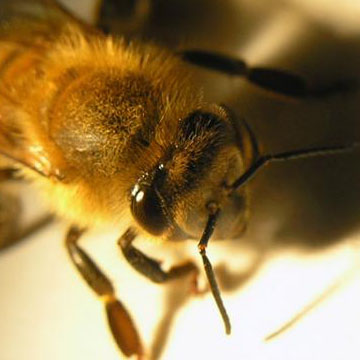
New research reports that western honey bees (Apis mellifera) have much sharper eyesight than previously assumed. [Image: Elisa Rigosi / Lund University]
Honey-bee vision is surprisingly complex, given that the minute creatures have less than a million neurons in their tiny brains. Their relatively simple brain structure makes bees an important biological model for studying visual perception, learning and memory. Now, a group of researchers from Sweden and Australia say that the visual abilities of the western honey bee—the most common type of honeybee, and one whose vision system has been studied for over 100 years—are far better than previous studies have shown (Sci. Rep., doi: 10.1038/srep45972).
Led by postdoctoral fellow Elisa Rigosi of Lund University, Sweden, the researchers exposed the bees to a bright display. They then took electrophysiological recordings of the neural responses of individual photoreceptors in the bees’ retinas. Results from their work will not only inform basic research in honey bee biology, but may also be useful for designing biomimetic robot vision.
Testing bee vision
Even though the visual abilities of honey bees have been studied for more than a century, most research has been conducted in dark laboratories far removed from the daylight environments in which the bees normally function. Light is an important factor for insect vision—it causes pigment cells in the eye to constrict, which sharpens angular resolution by as much as a factor of two. Therefore, the researchers say, these dark-state studies could have produced results that underestimated the insect’s visual acuity and limits.
Rigosi, along with Steven Wiederman and David O’Carroll from the University of Adelaide, Australia, report new methods to study honey-bee vision in bright conditions and to measure the reaction of single photoreceptors adapted to bright-light conditions in the frontal region of the eye. Using these methods, the researchers report having more accurately calculated the smallest objects that a bee can see (angular sensitivity) as well as how far away a bee can see an object (feature detectability threshold).
As far as the little eyes can see
To determine the bees’ angular sensitivity, the researchers recorded how individual photoreceptor receptive fields across the eye adapted to red, green or blue bars of light from a liquid-crystal display monitor. Photoreceptor activity data showed that honey bees can clearly see objects as small as 1.9 degrees, which is 30 percent better than previous reports.
To test the bees’ feature detectability threshold, the team recorded deflections in membrane potential induced by dark objects of various sizes drifting through the receptive area of the bees’ visual field. The measurements revealed that the smallest object a bee can detect is about 0.6 degrees—five times smaller than previous estimates.
“These new results suggest that bees have the chance to see a potential predator, and thus escape far earlier than what we thought previously, or perceive landmarks in the environment better than we expected, which is useful for navigation and thus for survival,” says Rigosi.
